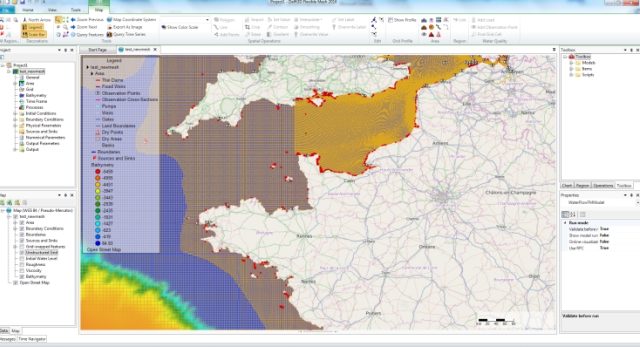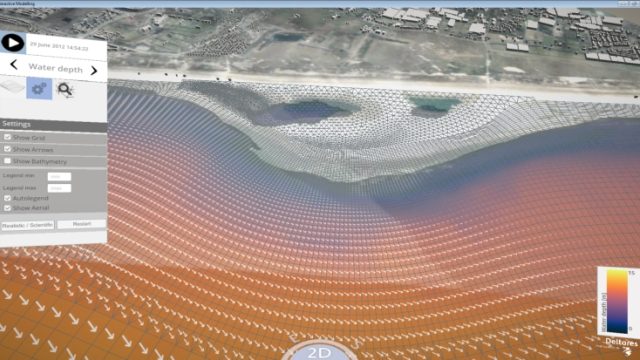D-Flow Flexible Mesh
D-Flow Flexible Mesh (D-Flow FM), as the successor of Delft3D-FLOW and SOBEK-FLOW modules, is capable of handling curvilinear grids that provide very good performance in terms of computational speed and accuracy. In addition to this, the grid may also consist of triangles, quads, pentagons and hexagons. This provides optimal modelling flexibility and ease in setting up new model grids or modifying existing ones, or locally increasing resolution.
D-Flow Flexible Mesh (D-Flow FM) is the hydrodynamic simulation module of the Delft3D FM Suite developed by Deltares.

Flow solver
D-Flow FM implements a finite volume solver on a staggered unstructured grid. The higher-order advection treatment and near-momentum conservation make the solver very suitable for supercritical flows, bores and dam breaks. The handling of wetting-and-drying makes it suitable for flooding computations. The continuity equation is solved implicitly for all points in a single combined system. Optionally, non-linear iteration can be applied for very accurate flooding results. Furthermore, Coriolis forcing, horizontal eddy viscosity, tide generating forces and meteorological forcings were added, making the system suitable for tidal, estuarine or river computations.

The D-Flow FM module of the Delft3D FM 2025 release fully supports hydrodynamic modelling for 2D horizontal applications and 3D applications for transport of salinity, temperature, and conservative tracers. In the D-Flow FM, Sigma-coordinates, Z-coordinates, and Z-Sigma-coordinates are possible in the vertical. Depending on the application, one of these co-ordinate systems can be chosen. For deep water applications (roughly deeper than one kilometer) Z-Sigma-co-ordinates are preferred. In this way, relatively thin Sigma-layers of a few meters near the surface can be combined with Z-layers of an increasing thickness in deeper parts.
For 3D modelling, three turbulence models are available: algebraic, k-epsilon and k-tau. Vertical transport can be solved both explicitly and implicitly.
Temperature modelling is supported either using the composite heat flux model or the excess heat flux model, which can both be driven by space-and-time varying metereological datasets.
Time integration is done explicitly for part of the advection term, and the resulting dynamic time-step limitation is automatically set based on the Courant criterium. The possible performance penalty can often be remedied by refining and coarsening the computational grid at the right locations.
Parallellisation
D-Flow FM models can be run as parallel computations on distributed-memory high-performance computing clusters. The parallel version is based on the familiar MPI standard, and partitioning of the model domain can be done automatically by the (included) METIS-partitioner, and/or defined by the user. Parallel computing is functional both on Windows and Linux. On Linux the PETSc matrix solver library can be coupled, and this is the preferred way for good performance. On single machines with multi-core processors speedup can also be achieved by D-Flow FM’s built-in OpenMP-multithreading option, which is the default setting.
1D2D and 2D3D Suites
For 1D2D and 2D3D modelling, the D-Flow FM module is available in Delft3D FM Suite 1D2D and Delft3D FM Suite 2D3D respectively. These suites provide specific graphical user interfaces to meet your needs.
The Delft3D FM Suite 1D2D as the envisioned successor of the SOBEK Suite will be available soon. See also SOBEK and Delft3D FM Suite 1D2D.
Delft3D FM beta testing – research programme
The Delft3D FM Suite undergoes continuous development and improvements in functionalities and user requirements. All newly developed functionalities are thoroughly tested by the Deltares developers and by members of our beta testing – research programme before being made available to the general public. Members of the beta testing - research programme are able to utilize all beta functionality of Delft3D FM for testing and research purposes only. If you would like to be a part of the beta testing – research programme community, please contact software@deltares.nl.


